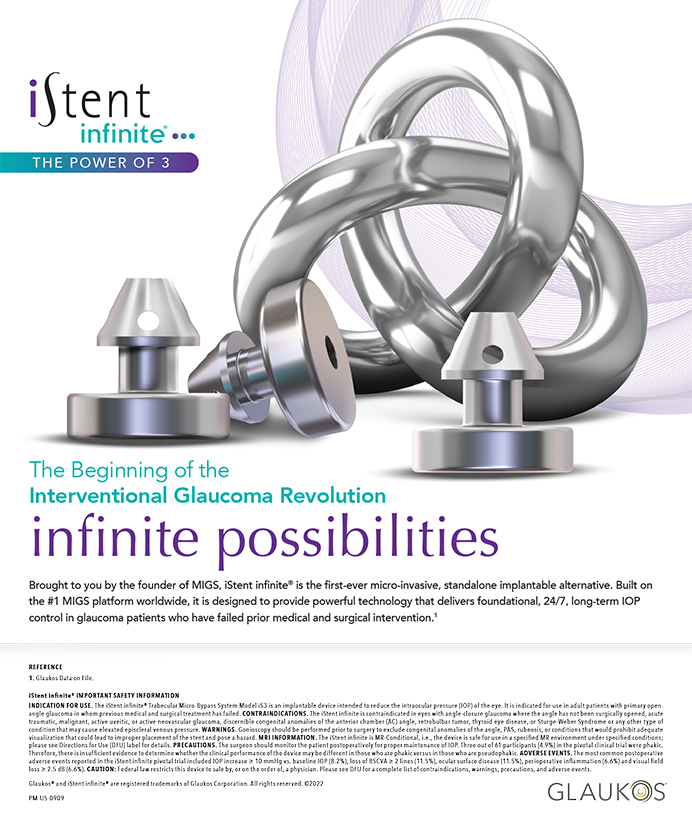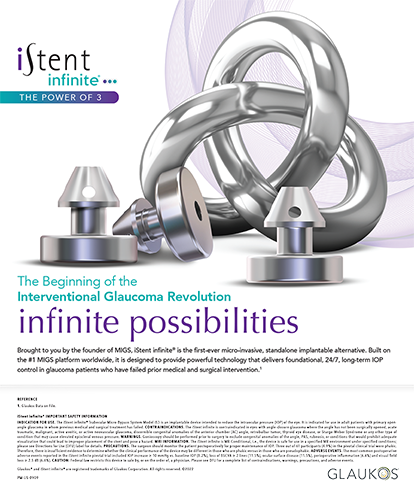The single most important component of providing good surgical outcomes for patients with refractive IOLs is the treatment of residual corneal astigmatism. Astigmatism decreases visual acuity through meridional blur; one axis of the cornea is steeper than the other, causing the cornea to distort images. As little as small as 0.50 D of astigmatism may result in glare, symptomatic blur, ghosting, and halos. If we want to provide our refractive IOL patients with successful surgical outcomes, we need to treat their residual postoperative astigmatism. Although ophthalmologists can accomplish this goal with excimer photoablation and conductive keratoplasty, they should not dismiss limbal relaxing incisions (LRIs) as a valid alternative. Furthermore, reducing corneal astigmatism with LRIs is more cost effective and convenient than other techniques. Here is why I think all refractive IOL surgeons should know how to perform this simple and effective procedure.
ZERO TOLERANCE POLICY
A common belief about refractive surgery is that patients who receive presbyopia-correcting IOLs willingly tolerate small refractive errors after cataract surgery. In fact, nothing could be further from the truth. These individuals are incredibly sensitive to even minor refractive errors, including astigmatism. I have found that most patients can tolerate postoperative astigmatism of 0.50 D or less. If their preoperative topography suggests they will have between 0.50 and 1.50 D of residual cylinder, I plan to perform LRIs. I do not treat such a small degree of astigmatism with excimer photoablation, because I believe this procedure exposes patients to unnecessary expenses and potential postoperative complications. I reserve laser treatment for patients who have more than 1.50 D of postoperative astigmatism.
PATIENTS WILL NOT PAY
It is true that most insurance plans, including Medicare, do not reimburse surgeons for correcting preexisting corneal astigmatism during cataract surgery. Patients, therefore, must pay out of pocket for this service. I have found, however, that most patients are happy to pay for markedly improved uncorrected vision, which is why I usually bundle the cost of LRIs with any additional charges for multifocal or accommodating IOLs.
NOMOGRAMS ARE TOO COMPLEX
Notable surgeons such as Louis "Skip" D. Nichamin, MD1; Douglas Koch, MD2; and James Gills, MD,3 have proposed different nomograms for correcting small amounts of cylinder with LRIs. Although these formulae are meant to simplify the placement of the incisions, their specific adjustments for age and cylinder can give the impression that the procedure is overly complex, precise, and unforgiving. Instead, I believe that LRIs are as much an art as a science.
In general, it is best for surgeons to practice the basic techniques for placing LRIs and eventually develop their own nomograms to achieve consistent results. This is how I developed the simple nomogram (the Donnenfeld nomogram or DONO) that I use in my practice (Table 1).
THE DONNENFELD NOMOGRAM
For surgeons new to LRIs, I suggest beginning by performing the procedure in the OR in conjunction with routine cataract surgery. I recommend adding peribulbar anesthesia to the operative regimen.
I place LRIs at the beginning of cataract surgery, because I prefer to work with a firm, well-hydrated eye. The cornea tends to become thinner as it dehydrates under the operating microscope. I determine where to place the corneal incisions by referring to a printout of the patient's preoperative corneal topography. I hold the map upside down to orient the patient's position on the operating table. Next, I grasp the episclera at the limbus with a 0.12-caliber forceps approximately 180° away from the incision's intended site. To place the incision, I apply a diamond blade (usually preset to 0.6 mm) to the eye and hold it in place for a second to ascertain that I have achieved the full depth before extending the cut to the length required to correct the targeted amount of astigmatism.
When placing LRIs, it is important to consider how the surgically induced cylinder will affect the patient's existing astigmatism. For example, because I make superior incisions, I will include an additional 0.50 D of against-the-rule cylinder to an LRI intended to treat a 0.50 D of preexisting against-the-rule cylinder. On the other hand, I know that my surgical technique will correct 0.50 D of cylinder in a patient who has with-the-rule astigmatism. Surgeons who prefer an oblique approach or are who treating a patient with oblique astigmatism can use a vector analysis of the preexisting cylinder and the cylinder induced by the incision to determine the location and length of the LRI. A new Web site, www.lricalculator.com, provides a vector analysis of the preexisting corneal astigmatism and the surgically induced cylinder. The Web site then calculates the new cylinder to be treated as well as the axis and creates a surgical diagram and plan, which can be copied and brought to the OR.
INADEQUATE EQUIPMENT
Another inaccurate assumption about why surgeons hesitate to perform LRIs is that they are not comfortable with this technique. Instead, I think that surgeons do not perform LRIs as often as they could because they do not have access to operating microscopes in their offices. A simple solution in this situation is to perform LRIs at the slit lamp (Figure 1).
I prepare patients for in-office LRIs by anesthetizing their eye with lidocaine gel. When I am satisfied that the patient's head is positioned correctly on the chin rest, I look at his eye through the phoropter and use a diamond blade to create a small LRI, just as I would under an operating microscope. One small incision will correct 0.50 to 0.75 D of cylinder. The whole procedure takes approximately 30 seconds, and the patient's vision improves immediately. To prevent postoperative inflammation and infection, I prescribe prednisolone acetate 1 and gatifloxacin 0.3 q.i.d. for 5 days.
CONCLUSION
I believe that LRIs are underutilized for correcting residual astigmatism after the implantation of presbyopia-correcting IOLs. Ophthalmologists who successfully transition from cataract to refractive IOL surgery do so, because they pay attention to the details that improve their patients' visual outcomes. For many of these surgeons, this means learning to perform LRIs.
Eric D. Donnenfeld, MD, is a partner in Ophthalmic Consultants of Long Island and is trustee of Dartmouth Medical School in Hanover, New Hampshire. Dr. Donnenfeld may be reached at (516) 766-2519; eddoph@aol.com.


